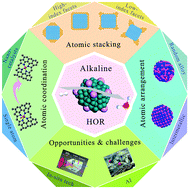Atomic-level insight into reasonable design of metal-based catalysts for hydrogen oxidation in alkaline electrolytes
Abstract
Anion exchange membrane fuel cells (AEMFCs) are becoming highly attractive for hydrogen utilization owing to the advantages of employing economic catalysts in alkaline electrolytes. Nevertheless, the kinetics of the anodic hydrogen oxidation reaction (HOR) in alkaline electrolytes, even catalyzed by the state-of-the-art Pt catalysts, is two orders of magnitude lower than that in acidic systems. Accordingly, developing highly efficient electrocatalysts for the HOR in alkaline electrolytes becomes fundamentally important and especially urgent. Here, the reaction mechanism of the HOR under alkaline conditions is briefly presented as the prerequisite for investigating catalysts towards the alkaline HOR. Meanwhile, the critical roles of the atomic coordination configuration, atomic stacking behaviors and atomic arrangement of metal-based catalysts in catalyzing the HOR under alkaline conditions are systematically discussed to provide atomic-level understanding for the development of HOR catalysts. Furthermore, potential synthesis methods of metal-based catalysts with well-confined structures are illustrated. Finally, the remaining challenges and promising avenues for efficiently developing catalysts towards the alkaline HOR are highlighted for future studies in this field.

- This article is part of the themed collection: Energy and Environmental Science Recent Review Articles


 Please wait while we load your content...
Please wait while we load your content...